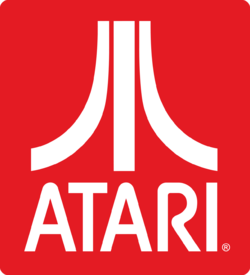Atari
| Atari | |
 |
|
| Founded | June 28, 1972 |
| Headquarters | Milpitas, California, USA |
Atari, founded by Nolan Bushnell, was one of the first video game companies. They pioneered the industry with an arcade release of Pong, and later entered the home market with the Atari 2600, 5200, and the 7600. They also made a series of home computers like the Atari 400 and 800, as well as the later Atari ST. After the NES was released, Atari created a separate company called Tengen, which produced unlicensed games for home computers and consoles. During the video game crash of 1983, Atari was bought out by Midway, who ported several Atari games to home consoles. Atari was bought out again by Infogrames who changed their name to Atari SA due to the popular name recognition.
At first, Atari had a strict no-credits policy, causing some employees to found Activision, but later on, Atari had the policy to use developer's initials in the high scores of the arcade games, and developer's info as an Easter egg on console games, but later, Atari's policy was changed, so most of their arcade games allow you to see the credits after waiting after several demos, and decided to put credits on the back cover of Atari 2600/Atari 5200 and Atari 8-bit games before the split (this was instituted by James J. Morgan, who had to recognize the developers very treatly).
Contents
Games
Music Development
Arcade
Atari's arcade music software was called RPM (Rusty's POKEY Music) and was created by Atari programmer Russell Dawe. The composers would have to write the music in Music-V Language (pronounced Music 5). Dennis Harper and Peter Lipson later created RPM-2, an updated version of the first RPM that supported the Yamaha 16-bit FM synthesis chips that were used in the Yamaha DX9 synthesizers (YM2151). Earl Vickers had negotiated with Yamaha Corporation for Atari to be the first company to use the chip. Brad Fuller said that though they received documentation from Yamaha for the YM2151, the documentation was completely in Japanese, and so he had to manually figure out how the sound chip worked and had to poke the registers to do so. He eventually figured it out, and was able to implement its technology into the 6502-driven RPM. Fuller also said that while Marble Madness was the first released game to use the chip, Paperboy was intended to be the first title to use it, but due to delays in development, its release was pushed back, and so Marble Madness was the first.
According to Brad Fuller, compiling the music was an arduous process. The music was usually written on sheet music with the notation written down. Next, the composer would take their compositions to a VT100 terminal connected to a DEC machine. Here, all the notation for the sound driver was input. Then, the music had to be compiled through the computer. After compilation (which took about 5 to 10 minutes), they would take their code to a Whitebox development system to download the code. After downloading, the composer could hear their music played back. If any mistakes were made, the composer would have to go back and fix their code and repeat the process until it was properly fixed.
Later on, Atari developed tools to make the creation process more efficient.
Sound effects for Atari's games were not made through RPM, but rather a program created by Yamaha; a separate program made for the POKEY and Yamaha FM chips. Sound effects were made as 'Instruments'.
Fuller explained that Atari had also developed a tool to convert MIDI files to the RPM driver. However, the sound team never used it, as writing the music in MML allowed them to be much more flexible with the music, rather than adhere to the limitations of MIDI.
Fuller later created the CAGE audio system (Configurable Audio Generation Engine), which was converted from RPM. The first game to use it was T-Mek, programmed by John Cage who passed away during its development, and the sound engine is named after his namesake.
For Cyberball, the sound hardware and driver were written by Vickers.
In Atari's later arcade titles such as Area 51 and Maximum Force, the games use the Cojag chip. The games were scored by Jeanne Parson and John Paul, respectively. Parson wrote her music in Logic for the Macintosh while Paul used Studio Vision Pro for the Macintosh, using SampleCell instrument samples.
Audio Personnel
These composers worked at Atari:
- Alex Rudis - Freelance composer.
- Barry Leitch - Composer.
- Brad Fuller - Lead composer.
- Byron Sheppard - Composer.
- Dennis Harper - Sound programmer, created RPM-2.
- Don Diekneite - Composer.
- Doug Brandon - Composer.
- Earl Vickers - Composer, voice programmer.
- Gunnar Madsen - Composer.
- Hal Canon - Composer.
- Jeanne Parson - Composer.
- John Paul - Composer.
- Lisa Ching - Programmer; converted RPM to the Sega Genesis.
- Michael Henry - Composer.
- Pablo Buitrago - Composer.
- Robert Vieira - Composer, wrote sound for Atari 2600 and 5200 games.
- Richard Marriott - Composer.
- Russell Dawe - Programmer; created the RPM sound engine for all of Atari's PSG and FM-based arcade games.
- Sean Gugler - Composer.
- Synthia Petroka - Composer.
- Tod Frye - Programmer; wrote audio for games he worked on.
Hardware
Game Platforms
Atari created several platforms both as video game consoles and home computers.
Video Game Consoles
Home Computers
- Atari 8-bit (400/800/XL/XE)
- Atari ST (ST/STE/TT/Mega STE)
- Falcon030
Handheld
Sound Devices
Picture Gallery
Links
- en.wikipedia.org/wiki/Atari - Wikipedia.

